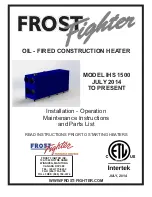
8
9
Los calentadores están diseñados para calentar la pieza de trabajo hasta una
temperatura máxima de 240
o
C con la excepción de los modelos de la serie
VHIN10, en los que la temperatura está limitada a un máximo de 150oC y de los
calentadores personalizados especiales, en los que la temperatura máxima puede
ser tan elevada como 480
o
C.
Los calentadores por inducción Timken pueden utilizarse de manera continua. Sin
embargo, existe una limitación: no deben ponerse en funcionamiento a una temperatura
de 240
o
C o superior durante más de media hora. Al realizar el calentamiento con la
función de tiempo, esto ha de verificarse con un termómetro externo.
PRECAUCIÓN:
• Los rodamientos deben calentarse generalmente sólo hasta una
temperatura máxima de 120
o
C.
• Los rodamientos de precisión sólo deben calentarse a una
temperatura máxima de 70
o
C. Calentar a temperaturas superiores
puede afectar a la estructura metalúrgica y a la estabilidad
dimensional, provocando un fallo prematuro de los rodamientos
o una pérdida del rendimiento de los rodamientos.
• No utilice calentadores por inducción para rodamientos
o piezas de trabajo que estén fuera de las dimensiones
mínimas o máximas tal y como se especifican en los datos
técnicos (Apéndice 1).
• No apague el calentador con el conmutador principal
mientras se está realizando el ciclo de calentamiento.
Condiciones de funcionamiento
Diseñado para ser utilizado en un entorno industrial con una temperatura ambiente
de 0
o
C a 50
o
C, y una humedad atmosférica de entre el 5% y el 90%. El calentador
de inducción está destinado a su uso en interiores exclusivamente.
Principios de funcionamiento
El calentador funciona de la misma forma que un
transformador. La bobina primaria es el calentador y la
bobina secundaria es la pieza de trabajo.
noticeheaterE.indd 8
17/10/06 14:04:42
Summary of Contents for VHIN 10
Page 204: ...noticeheaterRU indd 2 17 10 06 14 30 28...
Page 206: ...4 1 5 150o C 302o F noticeheaterRU indd 4 17 10 06 14 30 28...
Page 207: ...5 RU in out 1 noticeheaterRU indd 5 17 10 06 14 30 29...
Page 211: ...9 RU 3 3 230V 110V 1 2 400 450 500V 1 2 noticeheaterRU indd 9 17 10 06 14 30 30...
Page 212: ...10 4 noticeheaterRU indd 10 17 10 06 14 30 31...
Page 213: ...11 RU 5 5 2 1 in out noticeheaterRU indd 11 17 10 06 14 30 32...
Page 214: ...12 5 1 2 150 C noticeheaterRU indd 12 17 10 06 14 30 34...
Page 216: ...14 6 240 464 F VHIN10 noticeheaterRU indd 14 17 10 06 14 30 38...
Page 219: ...17 RU 8 noticeheaterRU indd 17 17 10 06 14 30 38...
Page 224: ...noticeheaterPRC indd 2 17 10 06 14 32 31...
Page 226: ...4 1 5m 16ft 150o C 302o F noticeheaterPRC indd 4 17 10 06 14 32 32...
Page 227: ...5 PRC in out 1 3 3ft noticeheaterPRC indd 5 17 10 06 14 32 32...
Page 231: ...9 PRC 3 3 230V 110V 1 2 400 450 500V 1 2 noticeheaterPRC indd 9 17 10 06 14 32 34...
Page 232: ...10 4 noticeheaterPRC indd 10 17 10 06 14 32 34...
Page 233: ...11 PRC 5 5 2 1 in out noticeheaterPRC indd 11 17 10 06 14 32 35...
Page 234: ...12 5 1 2 150 C 302 F noticeheaterPRC indd 12 17 10 06 14 32 37...
Page 236: ...14 6 2 4 0 o C 4 6 4 o F VHIN10 noticeheaterPRC indd 14 17 10 06 14 32 41...
Page 239: ...17 PRC 8 noticeheaterPRC indd 17 17 10 06 14 32 41...
Page 244: ...Notes noticeheaterGB indd 22 17 10 06 15 56 16...
Page 245: ...Notes noticeheaterGB indd 22 17 10 06 15 56 16...
Page 246: ...Notes noticeheaterGB indd 22 17 10 06 15 56 16...
Page 248: ...A1 noticeheaterGB indd 24 17 10 06 15 56 20...
Page 249: ...A2 noticeheaterGB indd 25 17 10 06 15 56 38...
















































